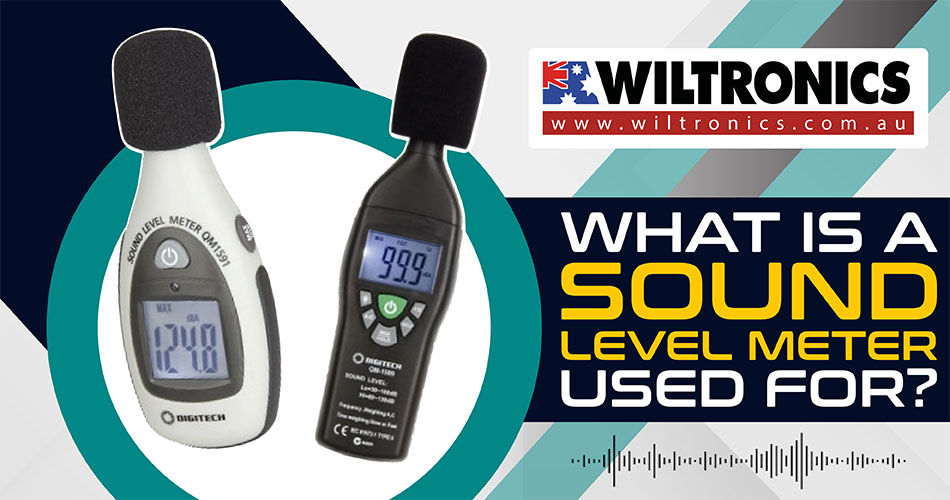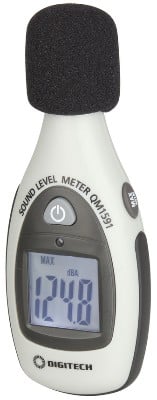What Is a Sound Level Meter Used For?
March 7, 2022

You can track and measure the strength of sound waves with a sound level meter.
Modern technology has paved the way for recording and playback devices like microphones and amplifiers. We also have an instrument for assessing sound levels in a standardised way — a sound level meter.
Sound level meters can respond to noise the same as human ears. Indeed, how they work is interesting.
They are gaining popularity, and many wonder what they are for and how to use them. In this post, we will shed light on what this device is all about (basics) and how to use it properly.
What Is A Sound Level Meter
A sound level meter is also called a decibel meter and sound pressure level (SPL). It is a sound pressure measuring instrument that uses a decibel scale.
Moreover, a sound level meter is generally for acoustic measurements. Acoustic means “sound that travels through the air”. This is opposed to audio meaning “sound that travels electronically through cables”.
SPLs need a microphone to measure the changes in air pressure produced by the sound source. The mic detects sound pressure deviations and converts them into electrical signals.
A preamplifier then makes the electrical signals stronger. And the better quality of the microphone, the more accurate the measurements will be.
As stated, sound level meters respond to sound much like a human ear. They give objective acoustic measurements of noise levels in a certain environment.
These measured noise levels are expressed in decibels (dB). Some models also show additional acoustic parameters on the instrument’s screen. For one, the equivalent continuous sound level (Leq).
What is a sound level meter used for?
As mentioned, this hand-held device is used to measure and manage noise from a variety of sources. This includes the following:
- Industrial plants
- Road and rail traffic
- Construction work
- Concerts
- Leisure parks
- Residential and commercial neighbours
However, these sound sources may pose challenges to professionals who assess them.
How does it work?
The instrument comprises a microphone, a preamplifier, signal processing, and a display. The most suitable type of mic is the condenser microphone. This type of mic combines precision with stability and reliability.
The electrical signal produced by the mic is at a very low level. This is where the preamplifier comes into play; it makes the signal stronger before the main processor processes it. Signal processing includes applying frequency and time weightings.
Further, sound level meters often have three-time weightings:
- Fast – has an exponential time constant of 125 ms. It corresponds approximately to the integration time of the ear. (Sounds of duration less than 125 ms do not register their full loudness with the average human subject.)
- Slow – has an exponential time of constant of 1s. Thus you can estimate the average level by eye with greater precision.
- Peak – has an exponential time constant of below 100 μs. It responds as fast as possible to the true peak level of transient sound.
Sound Level Meter Functions
Sound level meters are used where measurement and monitoring of noise levels are necessary. They may be utilised in different scenarios, but their main role depends on what environment they are used in.
Below are the common functions of a sound level meter.
1. Community noise analysis
A sound level meter is often used for measuring community or environmental noise. This device helps keep the general population safe from exposure to dangerous noise levels.
Great examples of community noise include traffic, construction sites, and playgrounds. Generally, authorities have specific regulations for industrial, construction, and residential environments.
Some of these sources are continuous, while others are less frequent. And these regulations differ depending on the time of the day. In some cases, community noise can also be measured for settling disputes between neighbours.
For measuring community noise accurately, separate measurements need to be carried out during the day and the night. Also, over a longer period to determine the average and highest peak of noise.
2. Building acoustics
The goal for measuring buildings and architectural acoustics is simple. It determines room acoustics, reverberation, transmission loss, and sound absorption. Also for testing acoustic material and sound insulation.
Understanding how sound travels and how it reacts to the environment is crucial for:
- Blocking unwanted sounds
- Creating the best experience for the users/audience
Some scenarios also include homes, restaurants, offices, lecture rooms, auditoriums, and concert halls.
3. Industrial noise control
Industrial environments are where decibel meters are used most frequently. The meter gets precise on-the-spot measurements and long-term monitoring of different industrial and construction noise.
Industrial Hygienists and Workplace Safety professionals use this device to assess workplace noise exposure. They conduct regular noise surveys and gather noise level data.
With a sound level meter, they can implement safety procedures and measures to keep employees safe from hearing damage.
4. Machinery noise analysis
Another function of sound level meters relates to product noise testing. Basically, they measure noise produced by machinery in the industries such as:
- Automotive
- Appliance manufacturing
- Firearms manufacturing
- Energy
- Agriculture
The main goal is to gather and analyse sound level data to help manufacturers develop quieter products.
Different Types of Devices
There are two types or classes of a sound level meter, and these are:
Type 1/Class 1
Type 1 or class 1 sound level meters are used for precision-grade assessments. Commonly used in laboratory testing.
Type 2/Class 2
Type 2 or class 2 are less complex. Commonly used for noise level assessments in industrial, educational, commercial, or residential scenarios.
How To Use The Device
Before investing in a sound level meter, make sure you know how to use one. General guidelines on how o use the device are as follows:
- Place the meter at a sufficient distance from any obstacles or reflectors;
- Put the microphone of the device about 1.3 – 1.5m above the ground;
- Put the mic in the direction of the sound source.
The measurement is likely to be affected by elements like the environment and different sound sources. For this reason, keep a record of the measurement conditions, such as:
- Type of sound level meter
- Number and duration of measurements
- Measurement location
- Time of the day
- Sound sources description
- Weather conditions for indoor us
Take note that the measurements will also depend on your distance from the source.
Find The Best Sound Level Meter Here

Digital Sound Level Meter
Product code: ME5588
This decibel meter device is ideal for checking the acoustics of recording studios, auditoriums, car sound and more! It features the following:
- Data hold
- Selectable time weighting in 2-stages
- High and low range selection (30 to 150 dB and 65 to 130 dB)
- A&C weighting
- Powered by a single 9V battery
The unit also comes with a digital screen, a tripod and a foam windshield. Perfect for beginners and professionals!

Pocket-Sized Micro Sound Level Meter 40dB to 130dB
Product code: ME5591
A pocket-sized sound level meter with a wide dynamic range of 40dB-130dB at a fair price. Type A-weighted for music and human hearing responses with a 4-digit LCD.
This smaller version of the decibel meter is ideal for environmental, safety, and also sound system testing.
The Bottom Line
A sound level meter is one of the effective ways of tracking and measuring noise pollution. It can monitor urban noises with known acoustic sound power like traffic.
If your job involves monitoring noise levels, a sound level meter is a worthwhile investment. Use it for multiple scenarios in factories or urban environments (e.g. air traffic).
To sum it up, sound level meters provide the ideal noise levels. This way, authorities can protect people who are exposed to high sound levels. This includes workers, city dwellers, and the general population.
© Electrotech Brands Pty Ltd 2022


Write a Comment
You must be logged in to post a comment.